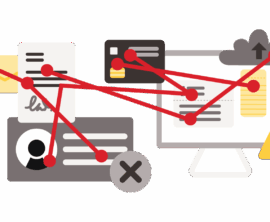Key takeaways
- Check crimes are on the rise, even though the use of checks is declining. Check fraud and check scams are two types of attacks used by criminals.
- If it seems too good to be true: Be alert for fraudulent checks you did not expect to receive or for amounts that are more than expected.
- Pay attention: Review your account statements carefully and frequently to catch and report any suspicious activity right away.
How does check processing work?
When a check clears, it means that the funds have moved from the payer’s bank to your bank, and usually the funds become available to you not long after. Some checks clear within two business days, but others can take seven business days or longer.
Why might a check take longer to clear?
Delays usually happen when:
- You’re depositing a large number of checks in one day, especially if they exceed the total available balance in the account.
- You’re a new customer
- Your account has frequent overdrafts over the past six months.
- Deposits of checks have already been returned unpaid.
- Your bank suspects the check won’t be paid.
Some checks can take longer to process, so your bank may need to hold some or all of the deposit for a little longer. Wells Fargo will let you know if we need to hold a deposit and include details about when to expect your money. If you think a check you deposited is fraudulent or fake, let your bank know right away.
Wells Fargo makes every effort to ensure that our customers’ money is safe. Awareness and vigilance are key to combating check fraud and scams. If you do see something of concern, contact Wells Fargo online, call us at 800-869-3557, or contact your financial institution and ask them to investigate and take appropriate action.
A common example
A woman in Georgia received an email from an individual who wanted to purchase furniture from her late aunt’s estate sale. She later received a check in the mail from this person for twice the amount of the furniture with a note asking her to pay the difference to a specific moving company and keep the remainder of the money “for her troubles.”
Does that sound too good to be true? It was. A Wells Fargo banker found red flags when she reviewed the check and customer’s emails: The name on the check did not match the name on the emails, and the address on the check was in a different state than the buyer said they lived. Sure enough, the banker investigated and discovered that the check had previously been cashed.
Scenarios like this one are becoming all too common. Although the use of paper checks has declined more than 7% per year since 2018, reports of check crimes (PDF) have almost doubled from 2021 to 2022. “As digital payments have become more secure, we’re seeing a significant increase since the COVID pandemic of fraudsters targeting paper checks to get people to unwittingly participate in a scam,” said Joe Bernardo, Wells Fargo head of Fraud & Claims Operations. “It’s easier to counterfeit a check than to break into someone’s online profile and send a fraudulent wire.”
According to the American Bankers Association, unprotected checks can offer criminals your name and other contact information, account and routing numbers, and even your signature to be forged on other documents.
Due to the increase in check schemes, Wells Fargo discourages the use of checks when possible. If you must use a check, here are ways to help you stay ahead of scammers.
First, know that check crimes boil down to two types of attacks: fraud and scams.
What is check fraud?
Fraudsters use the following methods to manipulate checks, which they present to a bank to be cashed or deposited into their own accounts.
- Check theft: Thieves acquire checks through normal day-to-day commerce, by stealing them out of personal and U.S. Postal Service mailboxes or even obtaining customer account and routing numbers through phishing scams. They endorse the checks or make a copy with their own information on it.
- Check washing: Criminals use chemicals to “wash” or erase the original ink on the check to then change the amount and/or payee.
- Check forging: Criminals create fake or counterfeit checks using legitimate routing and account information.
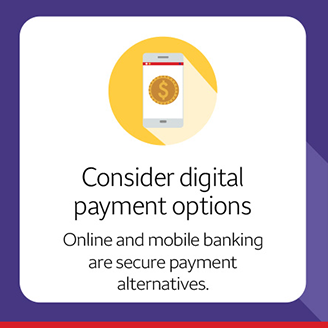
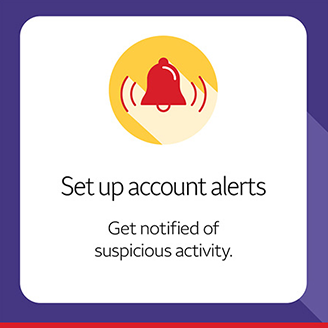
What are check scams?
According to the American Bankers Association, fake checks are one of the most common instruments used to deceive customers. The scam almost always involves someone sending you a check in exchange for some goods or services that is “accidentally” in an amount that is greater than what you need. They may make a plea for you to send the extra money back so they don’t lose their job. They may ask you to wire money to a foreign country, purchase gift cards, or mail cash.
“If you receive a check for more than you expected, take a pause,” said Bernardo. “It’s a tell-tale sign of a scam, so don’t deposit or cash it.”
Lately, check scams have come in the following flavors:
- Online marketplace sales: You post something for sale. The buyer sends you a check for more money than you expected. If you send out the item, you’ll be out the goods plus responsible for any of the funds that you spent.
- Social media: An artist or photographer messages you about a photo you posted, offering you money for the rights to use it. They’ll send you a check, then ask that you send some of the money back for supplies or similar.
- Lottery or prize: You receive a check in the mail for lottery or sweepstakes winnings. The check comes with instructions that you to send back a portion of the winnings to cover taxes, shipping charges, processing fees, or similar.
- Investment: You are alerted that you have a significant investment that’s made a profit, and then you are sent a check. Once you deposit the check, you are told that to cover the taxes or to access the funds, you’ll need to send money.
- New job: You interview with a company or an individual, either for an on-site or work from home assignment. After sending you a check as a signing bonus, they instruct you to deposit it and send back a portion or overage. Or you may be asked to purchase equipment and then ship it to an address that the fraudster has access to.
- Hardship scams: You might be approached by a new person at your job who says they haven’t had time to open a bank account, or even a stranger at an ATM who says they forgot their card at home — either way, their request is simple. They offer to sign over their check or a money order and ask that you cash it for them as a favor. They may even offer for you to keep some of the money for your trouble. The check or money order turn out to be fake, and you’re out the money.
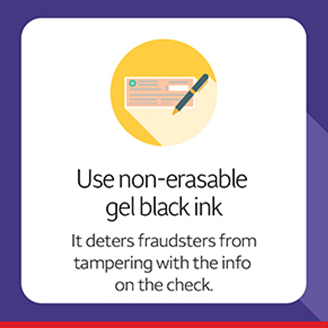
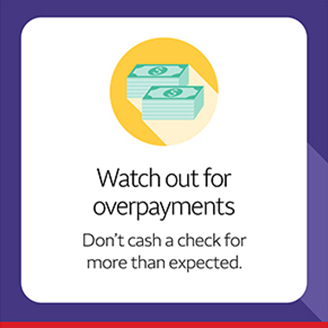
Easy ways to avoid check schemes
Bernardo shares these prevention tips:
- Use secure digital payment alternatives, such as online or mobile banking.
- Set up account alerts1 so you’re notified of activity.
- Write in non-erasable black ink.
- Keep checks secure so they cannot be stolen.
- Don’t accept checks from people you don’t know.
- Don’t accept or cash a check for more than is expected.
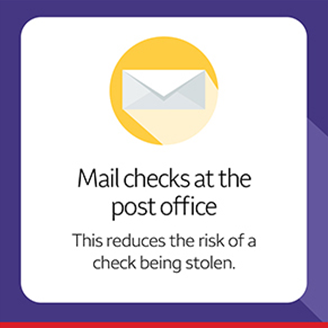
- Understand why you’re receiving the check and verify that it’s for legitimate purposes. If something seems too good to be true, it probably is. Trust your intuition and don’t make rushed decisions.
- If you must mail a check, drop it off at the post office instead of putting it in a mailbox. Then confirm with the recipient that they received your check.
- Review your accounts, statements, and cashed checks images frequently — at minimum, monthly. Report discrepancies immediately — account agreements specify timeframes to identify and subsequently dispute payments made by check.
FAQ
Check fraud happens when criminals steal legitimate checks and alter them through ink washing or forgery to redirect funds. In contrast, check scams use fake checks in schemes such as overpayments, lottery or sweepstakes winnings, or job offers to trick people into sending money to fraudsters.
Look for the warning signs:
- Is the check for more than you expected?
- Are you being pressured to quickly make the deposit, then return some of the money?
- Did you receive unusual instructions on how to deposit the check?
- Were you asked to send money back using an immediate form of payment, such as a money order, gift card, wire transfer, or cryptocurrency?
- Were you asked to give someone cash or an immediate payment through a payment apps?
- Are you being threatened with law enforcement action?
If you answered yes to any of these questions, don’t deposit the check. When in doubt, stop and let us help you.
Do not deposit or cash the check or send money back to the sender. Call Wells Fargo at 800-549-3557 or contact Wells Fargo or your financial institution and ask them to investigate and take appropriate action. You can also report the fraud to your local police or the Federal Trade Commission.
Follow these tips:
- Use secure digital payment options instead of paper checks when possible.
- Set up account alerts to monitor activity.
- Write checks in non-erasable black ink.
- Keep checks stored securely; never leave them in mailboxes.
- Drop mailed checks at the post office and confirm delivery with the recipient.
- Don’t accept checks from people you don’t know.
- Never cash or deposit a check for more than expected.
- Verify the reason for receiving a check. Pause if it seems too good to be true.
- Review account statements and check images at least once a month if not more.
- Report discrepancies immediately – account agreements specify timeframes to identify and subsequently dispute payments made by check.
Unfortunately, it can take weeks to discover a fake check after it’s been deposited. Funds from fake checks may appear available temporarily, but once the check bounces and is returned as fraudulent, the bank will reverse the deposit, and you may be responsible for the full amount of the fraudulent check. And if you send money back to a scammer, we may not be able to recover those funds.
With elder fraud on the rise (PDF), staying informed about the types of scams out there, knowing the warning signs, and preparing what to do and what not to do can keep you and your loved ones safe. Fraudsters often target older adults using low-tech methods like mailbox theft and impersonation scenarios involving fake IRS/Medicare representatives, grandchildren, love interests, or lottery/sweepstakes officials.
- Mail checks at the post office and confirm that recipients received them.
- Don’t deposit checks tied to lottery or sweepstakes winnings. They are likely counterfeit.
- Stay connected: Know your neighbors and keep in contact with family. Isolation can increase vulnerability to financial abuse.
- Pause before sending money from a recent deposit or overpayment. Discuss the situation with a banker or trusted friend. Be aware that scammers might tell you to lie about why you’re sending money.
- Limit the personal details you share on social media, which con artists can exploit.
Caregivers can help safeguard loved ones by communicating often, monitoring accounts, and watching for changes in behavior, such as unexpected requests for money or unusual payments.
Making your security a priority
The Security Center has the latest information on spotting and avoiding fraud and scams.




